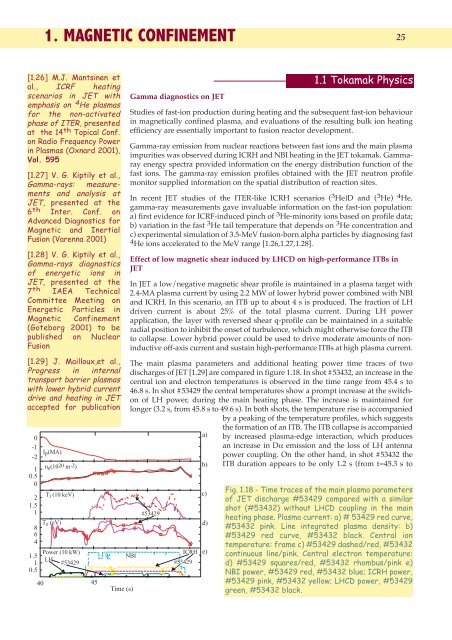1. magnetic confinement - ENEA - Fusione
1. magnetic confinement - ENEA - Fusione
1. magnetic confinement - ENEA - Fusione
You also want an ePaper? Increase the reach of your titles
YUMPU automatically turns print PDFs into web optimized ePapers that Google loves.
<strong>1.</strong> MAGNETIC CONFINEMENT<br />
25<br />
[<strong>1.</strong>26] M.J. Mantsinen et<br />
al., ICRF heating<br />
scenarios in JET with<br />
emphasis on 4 He plasmas<br />
for the non-activated<br />
phase of ITER, presented<br />
at the 14 th Topical Conf.<br />
on Radio Frequency Power<br />
in Plasmas (Oxnard 2001),<br />
Vol. 595<br />
[<strong>1.</strong>27] V. G. Kiptily et al.,<br />
Gamma-rays: measurements<br />
and analysis at<br />
JET, presented at the<br />
6 th Inter. Conf. on<br />
Advanced Diagnostics for<br />
Magnetic and Inertial<br />
Fusion (Varenna 2001)<br />
[<strong>1.</strong>28] V. G. Kiptily et al.,<br />
Gamma-rays diagnostics<br />
of energetic ions in<br />
JET, presented at the<br />
7 th IAEA Technical<br />
Committee Meeting on<br />
Energetic Particles in<br />
Magnetic Confinement<br />
(Goteborg 2001) to be<br />
published on Nuclear<br />
Fusion<br />
[<strong>1.</strong>29] J. Mailloux,et al.,<br />
Progress in internal<br />
transport barrier plasmas<br />
with lower hybrid current<br />
drive and heating in JET<br />
accepted for publication<br />
0<br />
-1<br />
I p (MA)<br />
-2<br />
n e (1020<br />
1<br />
m-2)<br />
0.5<br />
0<br />
T<br />
2 i (10 keV)<br />
<strong>1.</strong>5<br />
1<br />
T e (eV)<br />
8<br />
6<br />
4<br />
Power (10 kW)<br />
<strong>1.</strong>5<br />
LH<br />
1 #53429<br />
0.5<br />
40<br />
45<br />
Time (s)<br />
Gamma diagnostics on JET<br />
<strong>1.</strong>1 Tokamak Physics<br />
Studies of fast-ion production during heating and the subsequent fast-ion behaviour<br />
in <strong>magnetic</strong>ally confined plasma, and evaluations of the resulting bulk ion heating<br />
efficiency are essentially important to fusion reactor development.<br />
Gamma-ray emission from nuclear reactions between fast ions and the main plasma<br />
impurities was observed during ICRH and NBI heating in the JET tokamak. Gammaray<br />
energy spectra provided information on the energy distribution function of the<br />
fast ions. The gamma-ray emission profiles obtained with the JET neutron profile<br />
monitor supplied information on the spatial distribution of reaction sites.<br />
In recent JET studies of the ITER-like ICRH scenarios ( 3 He)D and ( 3 He) 4 He,<br />
gamma-ray measurements gave invaluable information on the fast-ion population:<br />
a) first evidence for ICRF-induced pinch of 3 He-minority ions based on profile data;<br />
b) variation in the fast 3 He tail temperature that depends on 3 He concentration and<br />
c) experimental simulation of 3.5-MeV fusion-born alpha particles by diagnosing fast<br />
4 He ions accelerated to the MeV range [<strong>1.</strong>26,<strong>1.</strong>27,<strong>1.</strong>28].<br />
Effect of low <strong>magnetic</strong> shear induced by LHCD on high-performance ITBs in<br />
JET<br />
In JET a low/negative <strong>magnetic</strong> shear profile is maintained in a plasma target with<br />
2.4-MA plasma current by using 2.2 MW of lower hybrid power combined with NBI<br />
and ICRH. In this scenario, an ITB up to about 4 s is produced. The fraction of LH<br />
driven current is about 25% of the total plasma current. During LH power<br />
application, the layer with reversed shear q-profile can be maintained in a suitable<br />
radial position to inhibit the onset of turbulence, which might otherwise force the ITB<br />
to collapse. Lower hybrid power could be used to drive moderate amounts of noninductive<br />
off-axis current and sustain high-performance ITBs at high plasma current.<br />
The main plasma parameters and additional heating power time traces of two<br />
discharges of JET [<strong>1.</strong>29] are compared in figure <strong>1.</strong>18. In shot #53432, an increase in the<br />
central ion and electron temperatures is observed in the time range from 45.4 s to<br />
46.8 s. In shot #53429 the central temperatures show a prompt increase at the switchon<br />
of LH power, during the main heating phase. The increase is maintained for<br />
longer (3.2 s, from 45.8 s to 49.6 s). In both shots, the temperature rise is accompanied<br />
by a peaking of the temperature profiles, which suggests<br />
the formation of an ITB. The ITB collapse is accompanied<br />
a) by increased plasma-edge interaction, which produces<br />
an increase in Dα emission and the loss of LH antenna<br />
power coupling. On the other hand, in shot #53432 the<br />
b) ITB duration appears to be only <strong>1.</strong>2 s (from t=45.3 s to<br />
NBI<br />
#53429<br />
ICRH e)<br />
#53429<br />
c)<br />
d)<br />
Fig. <strong>1.</strong>18 - Time traces of the main plasma parameters<br />
of JET discharge #53429 compared with a similar<br />
shot (#53432) without LHCD coupling in the main<br />
heating phase. Plasma current: a) # 53429 red curve,<br />
#53432 pink. Line integrated plasma density: b)<br />
#53429 red curve, #53432 black. Central ion<br />
temperature: frame c) #53429 dashed/red, #53432<br />
continuous line/pink. Central electron temperature:<br />
d) #53429 squares/red, #53432 rhombus/pink e)<br />
NBI power, #53429 red, #53432 blue; ICRH power,<br />
#53429 pink, #53432 yellow; LHCD power, #53429<br />
green, #53432 black.













